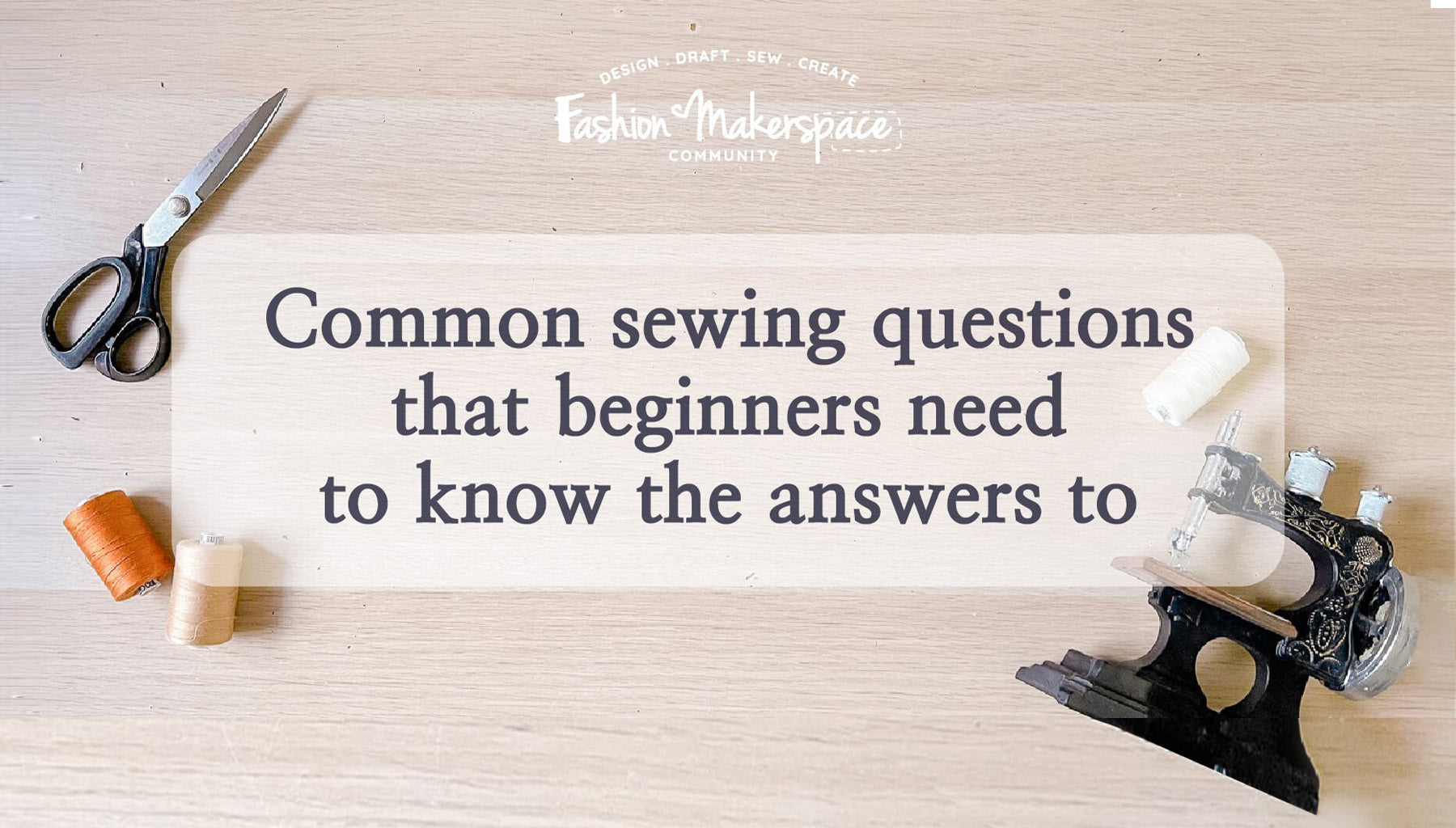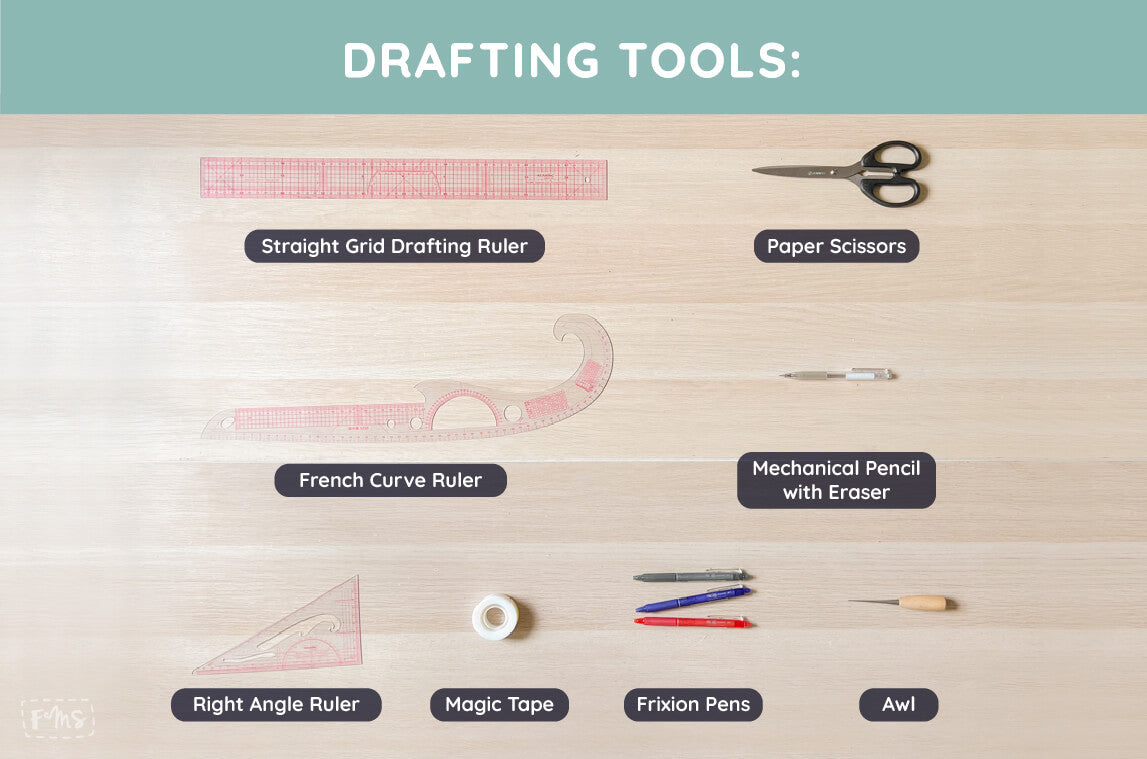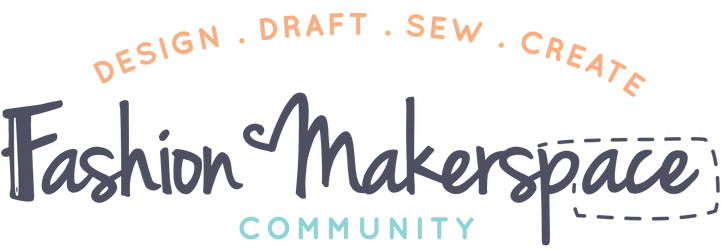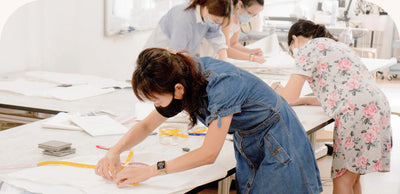
Most Common Sewing Questions that Beginners Need to Know!
Learning something new can be fun and exciting, but it's important to know what to expect when diving right into something unfamiliar! We compiled a list of the most common questions that beginners might ask right here together with the answers. Or if you prefer to learn in a classroom setting, check out our WSQ/Skillsfuture courses that are definitely a bang for your buck!
1. What tools do I need to start sewing and where can I buy them?
It's easy to get lost and mesmerised by the countless tools for sewing - though it might be a great addition to have that needle threader in your drawer, you actually just need the basic tools.
For anyone starting to sew and even for regular sewists, we divide your tool requirements into the Sewing Tools and the Drafting Tools for easier viewing. The brands that we like are also shown below!

Sewing Tools (Preferred Brands):
- Chalk Paper (Japan Chaco Paper)
- Sewing Threads (Coats, Gutermann or if you're on a budget, Rinata)
- Measuring Tape (Hoechstmass)
- Washable Chalk (Panda)
- Unpicker (Clover)
- Fabric Scissors (Kai)
- Snipper (Pin or Clover)
- Tracing Wheel (Prym or Sew Mate)
- Washable Fabric Marker (Kearing or Clover)
- Pins (Sew Mate, Clover or if you're on a budget, Newey)
- Hand Sewing Needles, optional

Drafting Tools (Preferred Brands):
- Straight Grid Drafting Ruler (Kearing or Clover)
- Paper Scissors
- French Curve Ruler (Kearing or Clover)
- Mechanical Pencil with Eraser
- L-Shape / Right Angle Ruler (Kearing)
- Magic Tape (3M)
- Frixion Pens, optional
- Awl, optional
Most of these tools can be purchased at Sing Mui Heng or Lye Nai Shiong. Other materials that you would need would be drafting paper and your preferred choice of fabric. This is according to your project needs and we list down some recommendations in the next question.
2. Which fabric is best for my sewing project?
It really depends. You might be tempted to get that silky fabric for your first project, but we would have to stop you there - certain fabrics are preferred for different designs and also for the different stages you are in your sewing journey.
For beginners, we recommend fabrics that are easy to work with in terms of cutting and sewing. As beautiful as all those fabrics out there may be - soft, silky, shiny and stretchy fabrics would heavily affect the accuracy and quality of your seams.
How soft, silky or shiny the fabric is depends on the material it is made of. Materials can mean cotton, denim, twill, satin, etc. Don't confuse these with the terms woven fabrics or knit fabrics! These refer to how the fabric is made, rather than what material the fabric is made of.
Woven fabrics are made with multiple threads that cross each other in right angles. On the other hand, knit fabrics are made from a single thread that is looped continuously to create a braided look. This makes woven fabrics less stretchy and easier to sew with compared to knit fabrics. Of course, under the woven family there are some fabrics that are also not ideal for beginners. Knit fabrics require some mastery with the sewing machine first and are not preferred if you're just starting out.

When you look closely, woven and knit fabrics are made differently.
Below are some woven fabric recommendations for beginners. These are often made from natural materials / fibres. Some indications of fabric in the light weight category would be fabrics like chiffon or cotton lawn. In the medium weight category we have fabrics like muslin or chambray and in the heavy weight category there's canvas, tweed and more.
LIGHT WEIGHT FABRICS
Recommended for tops or dresses. Often made from cotton or more than 50% cotton-blended fibres.
- Lawn
- Voile (very soft - handle with care!)
- Poplin
- Oxford
- Sateen
- Cheesecloth
- Soft Linen
- Lightweight Denim
- Seersucker
- Gingham
- Taffeta (slightly shiny)
- Muslin or Calico (often used for testing before using actual fabric due to its affordability)
HEAVY WEIGHT FABRICS
Recommended for bottoms or outerwear. Often made from natural fibres such as cotton or wool.
- Garbardine
- Tweed
- Twill
- Linen
- Broadcloth
- Denim
- Corduroy
OTHER HEAVY WEIGHT FABRICS
Recommended for accessories.
- Canvas
- Drill
- Twill
- Duck
- Denim
- Nylon (may be slippery)
- Other Upholstery Fabrics
Choosing your fabrics is probably one of the most enjoyable and creative parts of the process! But some fabrics are just that challenging to work with, so we would highly suggest to avoid using them if you're sewing for the first time.
These fabrics may be too slippery, too soft or are very stretchy and make it difficult to sew. Some examples of fabrics to avoid are listed below:

Fabrics like organza are not recommended for beginners.
POLYESTER OR SILK FABRICS
Often used for wedding / evening dresses.
- Chiffon
- Georgette
- Organza
- Satin
- Charmeuse
RAYON FABRICS
Found in undergarments or sleepwear.
- Viscose
- Modal
- Lyocell
3. Where are the best places to get fabric?
We recommend People's Park Complex in Chinatown. The 2nd floor of this building carries a wide array of fabrics ranging from cotton, lawns (often from the brand Liberty) and even chinoiserie fabrics and fancy jacquards. If you want an extensive list of our recommended stores to buy from and their operating hours, check out our other posts here and here.

Photo: shanehandmade.com
Most, if not all, the stores in this building carry the best competitive prices in town. The only downside is most of them close by 6pm and some even by 5:30pm - so make sure to check what the operating hours are of the stores you want to visit!
The next street spot where you can browse through a wide variety like this is on Arab Street. Their opening hours are a little earlier, at around 10am and they are home to a huge variety of silks, laces and luscious fabrics. Some shops have a more diverse range than others so you can check out our overview of Arab Street here.

Besides all these melting pots of fabric shops, stores like Sing Mui Heng and Spotlight deserve good mention too! They are generally all-in-one shops that sell everything from threads, fabrics and sewing machines. With multiple outlets and longer shopping hours, you might spend a lot of time browsing there.
If you can afford to wait and prefer to browse comfortably at home, then your next option would be to check out the online fabric stores. Happy shopping and support local when you can!
4. How much fabric should I get?
Use this diagram below to calculate your fabric consumption!

Fabric widths are generally fixed depending on what prints or designs you choose. They range anywhere from about 40” to 60”. The conversion between inches to cm is 1” = 2.54cm, so do your conversions beforehand.
Here is how you calculate your fabric consumption:
- Calculate the widest width and longest length of your largest patterns. (In green)
- See if your pattern width can accommodate your next big pattern beside it as shown in blue, OR if it has to be placed underneath as shown in red. This will give you a rough idea of how much fabric to buy.
- Consider the rest of the pattern pieces also in this manner. Generally, smaller pieces can fit within the smaller spaces in between whilst still being placed according to the pattern grain line. But consider buying an extra half yard/metre just in case you make some mistakes along the way!
5. Which sewing machine is suitable for me?
Sewing machines are generally categorised as mechanical, computerised, industrial and recently, semi-industrial. How these machines are categorised are based on how you are able to easily adjust the settings and the types of stitches available on the machine.

For beginner sewists, we highly recommend the entry-level computerised machines (which you can have a hands on experience at our Starter Bundle Class!). They carry the functions of speed control so you don't have to worry about pressing the pedal too hard. These machines also have beeping reminders when something isn't done right - like when the footer isn't placed down before sewing. Computerised machines are also able to automatically sew buttonholes which are very even and professional-looking.
The ideal sewing machines even for those with no experience or for kids are the Brother A16 and the Juki HZL-LB5100.
6. What is an overlocker and do I need it?
An overlocker/serger is a great machine to get depending on the projects that you intend to do and your expectations of the finishes on the fabric edges. They can work with both woven and knit fabrics! Overlockers basically neaten and prevent fabric edges from fraying.

So whether you need it, highly depends on your expectations for your end product - do you want professional looking edges or are you satisfied with a different finish? If you turn your ready-to-wear garments inside out, you can often find these overlock stitches along the edges of seams or hems.
We have tried multiple overlockers and brands, and it really comes down to 2 of our favourites: the Brother 1334D (4-thread) and the Juki MO-623 (3-thread).
So if you really want a professional finish to your projects, we highly recommend investing in an overlocker - but you might realise that these machines are actually quite a hit to your wallet. If you are on a budget, we also have some suggestions on some overlocker substitutes in the next question!
7. Overlockers seem pricey! Are there any alternatives?
Yes! There are many alternatives to reduce the fraying on the edges. These are some of our recommendations from the most professional to the least professionally finished edges:
- Add lining to your project (Most professional)
- Use closed seams to enclose the raw edges (French seams or flat-felled seams are good examples)
- Use bias binding tape
- Iron the edges with a seam binding tape and sew it down with an overcast stitch
- Use a zig-zag stitch along the edge of the fabric
- Cut the raw edges with pinking shears to create zig-zag edges

Just expect that these alternatives will take a lot more time - but if you can afford the time, then you can save the money on buying an overlock machine.
8. Do I really need to finish my edges?
Technically yes, unless you are going for a distressed look or if raw is your thing; or you never really intended to wash or wear it much. Otherwise, you may expect that the fabric edges will continue to fray with continued wash and wear.
9. Do I need to draw on my fabric for sewing?
Nope, you don't need to, provided your cutting is pretty accurate. The lines (seam guides) on the sewing machine are precisely there for you to visually align the edge of the fabric with, so that you can sew evenly according to the seam allowances. Even if you drew a line, there would still be a margin of error if your fabric slid underneath whilst tracing, so why bother when all you need to do is cut accurately according to the pattern and enjoy the payoffs after!
Of course this means that your sewing should ideally not be wavy or crooked, which just requires a bit of focus and some practice. So to save yourself the time, cut accurately and sew away!

Aligning your fabric to the seam guides on the sewing machine.
10. Which threads are best to get?
In many garment factories, the thread brand of choice is often Coats & Clark. However many good quality threads have emerged with the advent of home sewing. Locally, the premium brands that would give you a bang for your buck would include European brands like Gutermann, Madeira and Aurifil. We’ve included the shops where you can find these threads below. However, if you’re tighter on budget, then brands like Rinata also perform decently and will still hold your garment up well.
- Coats & Clark at Lye Nai Shiong
- Gutermann at Spotlight or Lye Nai Shiong
- Madeira at Stitch4you
- Rinata at Sing Mui Heng or Brighton
The worst of course, is to buy an “unknown brand” because these threads tend to fail at the “Breaking Test” - where you simply pull the threads apart with both hands and see how easy/hard it is to pull. Now good threads are harder to break, because they are very tightly spun and have fewer loose fibres. Whether they are made of polyester or cotton, the most important thing is that they are strong and fit your project needs.

For example, if you are sewing stretchy knits, you want to look for polyester threads that have some elasticity. If you’re doing embroidery, then you would want a very smooth and lustrous finish to these threads, which are often made from polyester fibres. If your project is very heavy, like quilts or curtains, then do invest in premium threads and yes, polyester is often chosen over cotton for its strength and durability.
11. What sewing machine needle should I use?
When looking for needles, make sure you get the ones for domestic machines (mechanical, computerised and semi-industrial) if you’re not using an industrial sewing machine. For sizing, the general rule of thumb is - thicker needles are for thicker fabrics, and thinner needles are for thinner fabrics. The needles that come with your sewing machine are generally good for most woven fabrics of medium weight.
In terms of the size number, they are often listed as 70/10, 80/12, 90/14 and so on, with the first number representing European sizing and the second number representing American sizing. Thank goodness they always combine the two in the product listing!
We highly recommend buying a pack of universal multi-sized needles for general keeping. You would need these needles when stitching knit fabrics (which tend to be stretchy - for example, jersey) as you do not want to cause breakage in these fabrics. This breakage will weaken the structural integrity of the knit and your garment will fall apart! To counter this, the universal needle has a ball-point, rounded edge that will find its way through the holes between the looping threads of knit fabrics without damaging it.
For which type of needles to use, we do recommend Schmetz’s Microtex needles for very lightweight fabrics as it is very sharp and minimises the holes in your fabrics. There are needles meant for jeans, leather and embroidery purposes, so try to get the right one suited for your project and your sewing will be a lot smoother. Just don’t forget to replace them if they start to cause bigger-than-normal holes in your fabric!

Photo: schmetzneedles.com
That's it for the most common questions asked by beginners - of course there are more questions out there, so if you have any issues or enquiries about sewing, reach out to us and we would love to help you!
No sponsorships were involved in this post.



